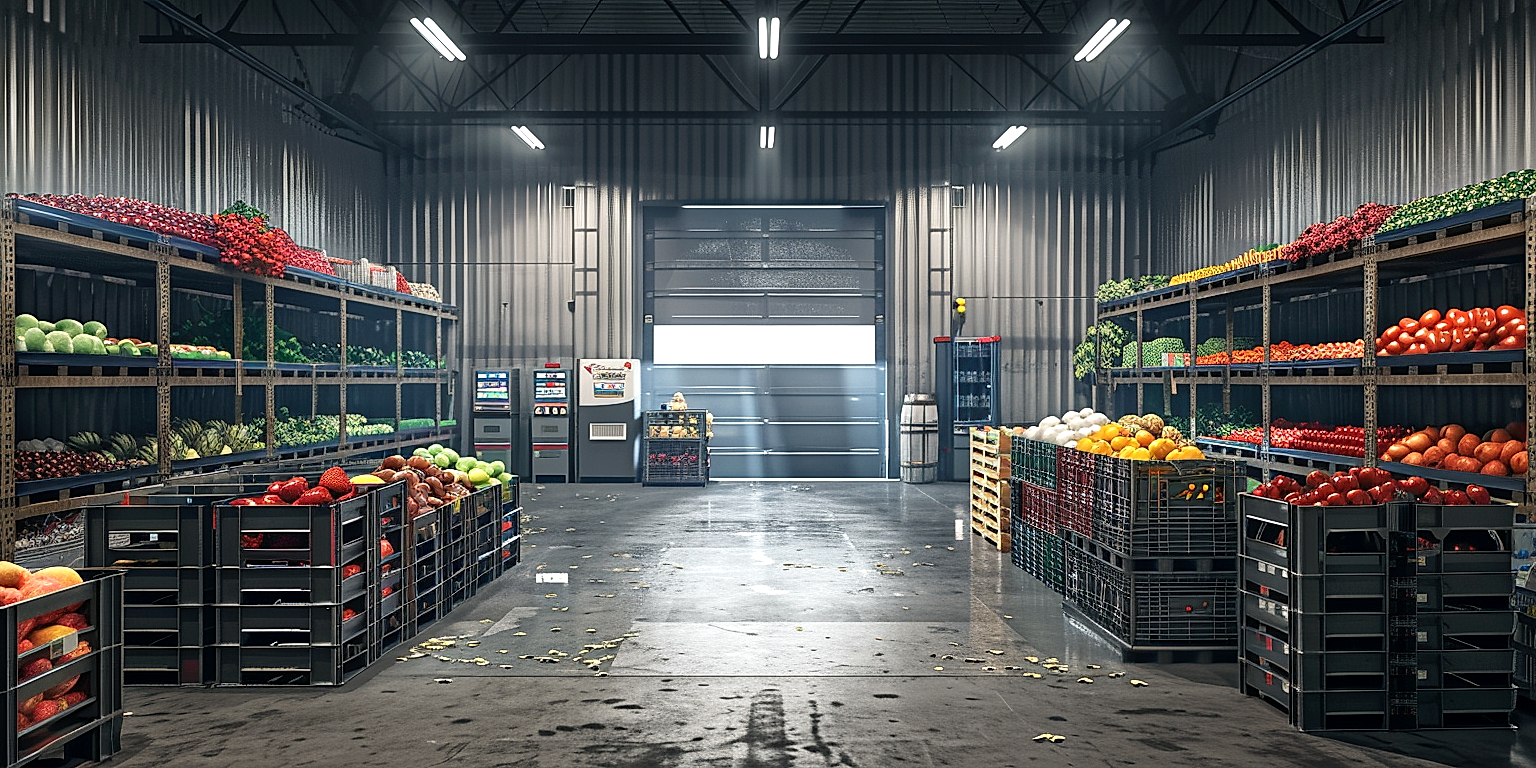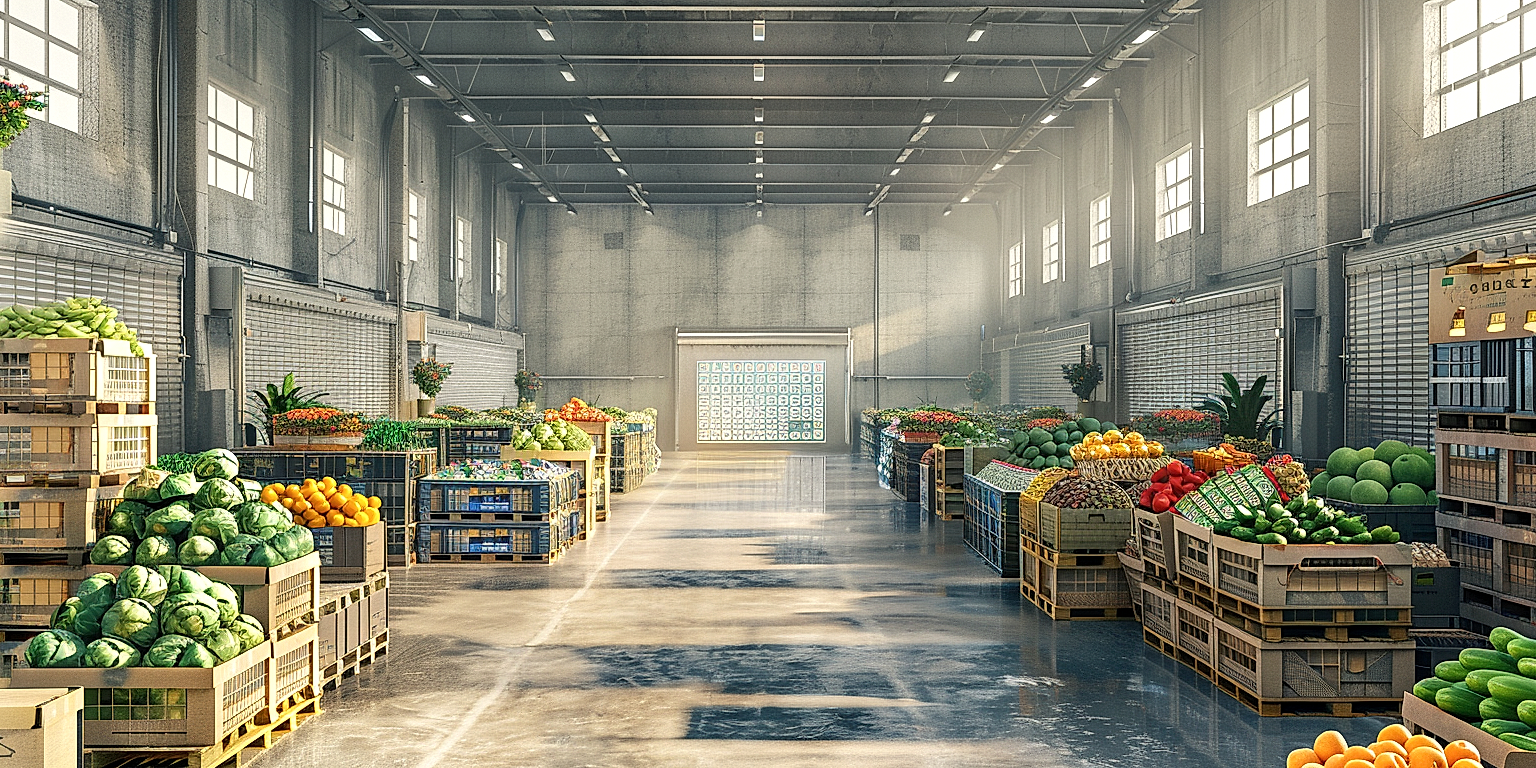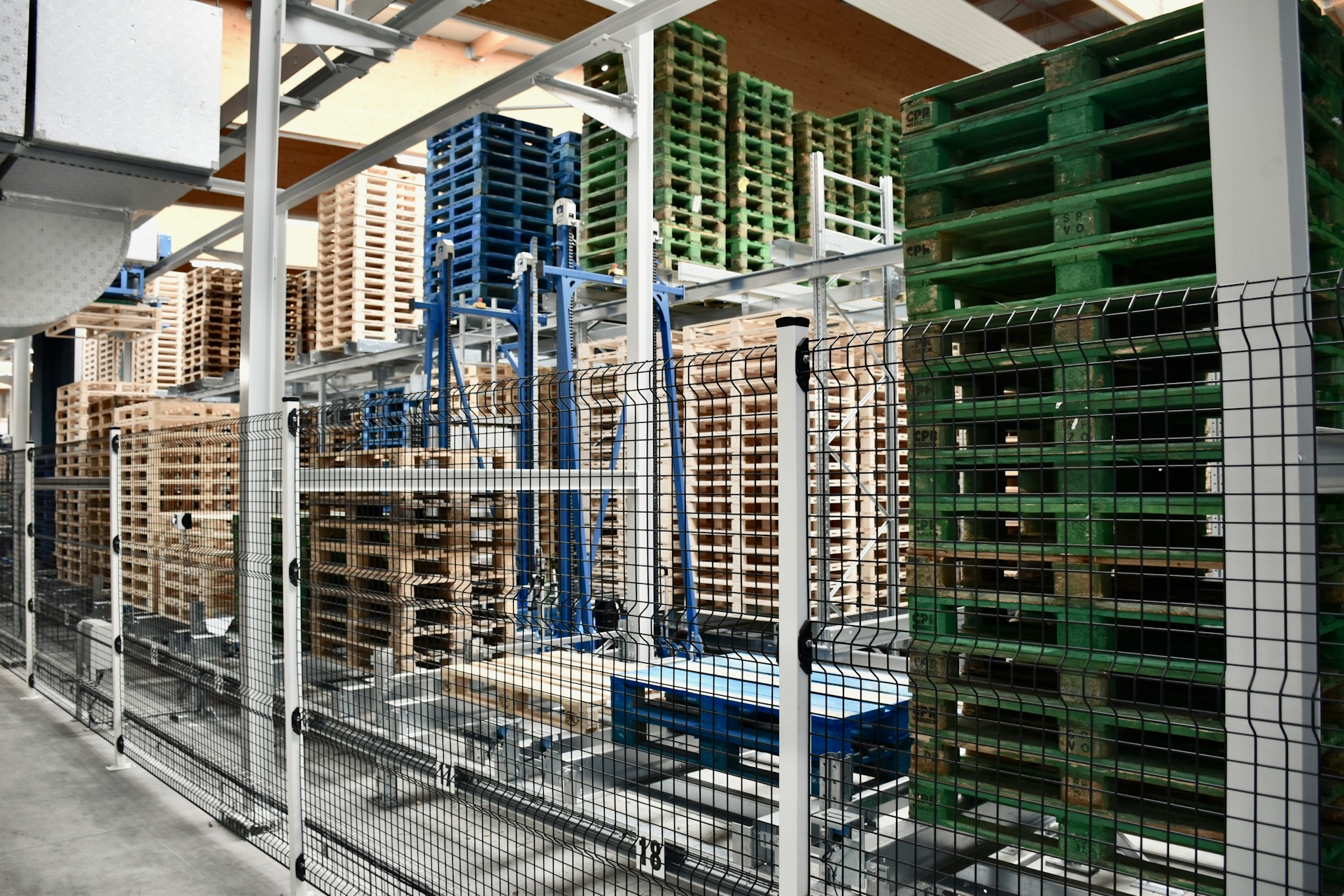Within the industry of produce distribution, safety is a paramount concern.
The purpose of this discourse is to explore some of the key safety measures implemented in warehouses, where the risk levels are often heightened.
Comprehending these protocols not only ensures the well-being of the employees but also guarantees the quality and safety of the produce.
By implementing robust processes and adhering to industry standards, potential hazards can be significantly mitigated.
This article shines a spotlight on these protocols.
The intention is to enlighten industry practitioners about best practices for maintaining a safe and healthy working environment.
Contents
- Safety Protocols For Produce Distribution Warehouses
- 1. Regular sanitation of storage and transportation areas
- 2. Implement temperature control for perishable items
- 3. Train Employees on Safety and Handling Procedures
- 4. Regular checks for pest infestations.
- 5. Adherence to food safety laws and regulations.
- 6. Implementation of Emergency Response Plans
- 7. Use of Proper Loading/Unloading Equipment
- 8. Regular maintenance of warehouse equipment
- 9. Ensure adequate ventilation in storage areas
- 10. Enforce mandatory use of protective clothing and gear
- The Bottom Line
Safety Protocols For Produce Distribution Warehouses
1. Regular sanitation of storage and transportation areas
The distribution of fresh produce requires a keen focus on sanitation of both the storage and transportation facilities.
It is an established best practice to carry out regular cleaning and disinfection of these key areas in order to maintain the high quality of the produce.
Thorough sanitation practices remove potential sources of contamination, such as bacteria, pathogens, and pests, which could negatively impact the quality and safety of the produce.
Regular sanitation also aids in maintaining the structural integrity of the storage and transportation facilities, which in turn ensures the safety of the produce.
Properly implemented sanitation protocols not only enhance food safety, but they also significantly extend the shelf life of the produce.
Effective sanitation should also cover the cleanliness of personal hygiene for those handling the produce, as well as the tools and equipment used in the distribution process.
A regular schedule for sanitation should be adopted, which includes prompt cleanup of spills and debris and regular power washing of storage and transportation spaces.
Appropriate waste disposal practices should be enforced as part of the regular sanitation process.
Such protocols ensure that waste materials do not become sources of contamination in the storage and transportation areas.
Cleaning agents used should be approved for use in food handling environments to ensure they do not introduce harmful residues.
Knowledge and proper use of these cleaning agents in the correct dilution and application is crucial in maintaining a safe environment for produce distribution.
Regular sanitation, coupled with good handling practices, can significantly minimise the risk of cross-contamination during the handling and distribution process.
Cleaning and sanitation records should be kept and regularly reviewed to ensure consistency and effectiveness of the sanitation protocols.
Such records prove useful in the event of a third-party audit or a food safety inspection.
Regular training for staff on the importance and proper procedures of sanitation is also a fundamental aspect of ensuring the safety protocols of a produce distribution warehouse.
In essence, regular sanitation practices are a quintessential part of guaranteeing the safety and quality of produce throughout the storage and distribution process.
2. Implement temperature control for perishable items
Given the perishable nature of the products, implementing temperature control is a critical safety protocol for produce distribution warehouses.
Maintaining a consistent and optimal temperature is key to preserving the quality and extending the shelf life of the products.
This not only ensures the safety and freshness of the items but also prevents monetary losses due to spoiling.
Different produce items require different temperature settings for storage and transport.
For example, strawberries and tomatoes are sensitive to cold temperatures and should not be stored at temperatures below 0°C while items like apples and potatoes require much lower temperatures
Hence, it is important for warehouse operators to be well-informed about the specific temperature requirements of each produce item.
Modern warehouses often use automated temperature control systems to maintain a consistent temperature.
These systems are equipped with sensors that continuously monitor temperatures and adjust them as needed.
This eliminates human error and ensures consistent temperature control.
Another factor that contributes to temperature control is the packaging of the produce.
Insulated packaging materials can help in maintaining the required temperature for a longer time during transportation.
Moreover, understanding the cooling methods and procedures for different produce is also crucial.
For instance, some items may need to be pre-cooled before storage or transportation to remove field heat.
While other produce items might require controlled atmosphere storage, which involves altering the oxygen and carbon dioxide levels along with temperature control.
Ultimately, successful temperature control requires a combination of the right equipment, knowledge and procedures.
Regular checks and maintenance of the temperature control systems are also key to ensuring their continued performance and reliability.
Therefore, temperature control is a complex but crucial aspect of warehouse safety protocols that requires careful planning and implementation.
3. Train Employees on Safety and Handling Procedures
Training employees on safety and handling procedures forms a crucial line of defense in maintaining the integrity and safety of produce in distribution warehouses.
Every employee should be trained on how to correctly handle and store different types of produce to minimize damage and spoilage.
Alongside this, employees should be comprehensively informed about the potential hazards in the warehouse, such as wet floors, moving machinery, and the risks associated with improper handling of produce.
Further, training exercises on how to respond effectively to incidents like fires, medical emergencies, and chemical spills should be well ingrained among the employees.
Employees should also receive ongoing training to keep them updated with the latest safety protocols and industry standards.
This can be ensured through periodic refreshers and seminars, ultimately fostering a culture of safety within the facility.
Regular evaluations should be conducted to gauge the efficiency of the training and to identify any potential areas of improvement.
These evaluations should then be used to modify and enhance the training program accordingly, ensuring the safety processes are up-to-date and effective.
Training should also be interactive, utilizing hands-on exercises to allow employees to practice safety procedures.
Inclusion of practical simulations makes the training more engaging, therefore enhancing its effectiveness.
Loading and unloading goods, for instance, should be practiced since it is an essential procedure that comes with potential hazards if mishandled.
Competency in equipment use should also be ascertained in the training sessions to ensure machinery is handled in the most safe and efficient way.
In the long run, well-trained employees not only improve safety measures but also significantly reduce accidents, injuries, and wastage within the warehouse.
They are also more likely to comply with safety regulations, ensuring that the warehouse maintains its reputation and avoids legal ramifications.
Ultimately, adequate employee training is vital for minimizing risks, ensuring compliance with safety regulations, and promoting efficiency in the operations of a produce distribution warehouse.
4. Regular checks for pest infestations.
Among various safety protocols proposed for produce distribution warehouses, an integral part is conducting regular checks for pest infestations.
Pests are a major concern in food storage facilities as they can contaminate the products and compromise their quality and safety.
To ensure the safety of all products stored, managers should implement pest management programs that include frequent pest inspections.
Inspections should be scheduled to occur at regular intervals, aiming not only to detect the presence of pests but also to identify any conditions that could potentially attract them.
By identifying these conditions early, proactive measures can be taken to prevent infestations from taking place in the future.
The pest management program should be well-documented, outlining protocols for inspection, pest identification, and suitable treatments.
A professional pest control company can be utilized to conduct these inspections and handle any pest problems adeptly.
Moreover, warehouse workers should also be trained on pest identification and informed ethical procedures to deal with them.
Training the workers will equip them with the knowledge to notice the initial signs of infestation and take timely action before the condition escalates.
During inspections, special attention should be given to examining corners, cracks, crevices, and other potential pest hideouts in the warehouse.
Additionally, pest infestation checks must extend to transportation vehicles to ensure that pests are not carried into the warehouse unknowingly.
By implementing a routine pest check, warehouses can maintain a pest-free environment for the safe storage and distribution of produce.
However, merely conducting the inspections is not enough; the observations made during these inspections should be recorded and analyzed to monitor pest activity trends over time.
This analysis will help in refining and fine-tuning pest control strategies, enabling the warehouses to keep their environments pest-free.
Keeping in close collaboration with the local health department can also be beneficial in understanding the local pest trends and incorporating required changes in the pest control measures.
In conclusion, consistent implementation and proper documentation of regular pest checks are the key to maintaining the safety and efficacy of a produce distribution warehouse.
5. Adherence to food safety laws and regulations.
Adherence to food safety laws and regulations is a paramount aspect of ensuring safety in produce distribution warehouses.
These regulations are defined by local, national, and international bodies, and often vary based on the type of products handled, stored, or transported.
All food handlers, including those in produce distribution warehouses, are legally bound to adhere to these safety laws.
Strict compliance to these standards is not only a legal requirement, but also a moral obligation to the consumers who trust the safety of the food products they consume.
Non-compliance could lead to severe legal consequences, including hefty fines, suspension of business licenses, and in some extreme cases, prosecution.
Therefore, it is critical to stay up-to-date with the latest amendments in food safety laws.
Each regulation usually encompasses a wide range of safety aspects, from cleanliness and hygiene to temperature control and pest infestation.
The safe storage, handling, and transportation of food items are covered extensively in these regulations.
Many of these regulations call for periodic audits and inspections by designated food safety authorities.
Such inspections ensure that warehouses are consistently adhering to the standard safety practices dictated by law.
Apart from these laws, there are also global food safety initiatives, which though not legally binding, are followed by many industry leaders.
Organizations adhering to these initiatives highlight their commitment to maintaining the highest standards of food safety.
Guidelines from such initiatives often inform updates in local food safety laws and regulations.
Hence, adherence to food safety laws is not merely a compliance issue, but a catalyst for implementing high standard safety practices that ensure consumer trust and business sustainability.
By following and exceeding these regulatory standards, produce distribution warehouses can serve as ideal models in the food safety chain.
Doing so not only ensures business legality but also contributes to the bigger role of preventing foodborne illnesses and establishing a safe food industry for everyone.
6. Implementation of Emergency Response Plans
In order to secure the safety of both employees and goods in a produce distribution warehouse, it is imperative to implement effective emergency response plans.
These plans should be designed to address a range of potential emergencies, such as fires, explosions, power outages, chemical spills, physical injuries, and natural disasters.
Through articulating and executing these comprehensive plans, warehouses can minimize the potential for severe damage and disruption to their operations.
Moreover, by facilitating a smooth and effective response to emergencies, these protocols can significantly reduce the chances of injury and ensure the continued safety of the workforce.The first step in establishing an effective emergency plan is to identify and assess potential risks.
If a warehouse stores hazardous substances, for example, the emergency plan should include procedures for handling potential leaks or spills of these substances.
In the event of a fire, evacuation procedures must be clearly outlined and communicated to all employees.
These procedures should be regularly reviewed and updated as necessary to ensure relevancy and accuracy.
Employee training is an integral part of the implementation of an emergency response plan.
All employees should be trained in understanding the plan, knowing their roles in case of an emergency, and reacting quickly and efficiently.
As part of the training, emergency drills can be staged to allow employees to gain practical experience in responding to an emergency situation.
When an emergency occurs, communication becomes critical.
The communication strategy should cover the notification of the emergency services, internal communication among employees, and any necessary communication with external entities, such as customers or suppliers.
The upkeep and testing of emergency equipment, such as fire extinguishers, first aid supplies, and emergency lighting, is another key element of the plan.
Finally, the review and improvement of the emergency response plan is essential after every emergency or drill to identify shortcomings and gaps which could potentially be improved.
In conclusion, the implementation of an emergency response plan is a crucial aspect of the safety protocols in a produce distribution warehouse.
7. Use of Proper Loading/Unloading Equipment
Safety protocols in produce distribution warehouses cannot be understated, particularly when it comes to the use of proper loading and unloading equipment.
Sticking to the standardized equipment approved for use in these facilities significantly decreases the likelihood of accidents occurring.
Warehouse operators should ensure that all machinery used in the process is up-to-date and meets the standards set by state and federal laws.
Training employees on how to correctly operate these machines can also play a crucial role in maintaining safety in the warehouse.
Proper use of loading and unloading equipment not only guarantees the safety of workers but also that of the produce being handled.
Therefore, well-maintained and correctly-operated equipment diminishes the chances of produce getting damaged, hence, managing to maintain the integrity and quality of the fruits and vegetables during transportation.
It also noteworthy to mention the significance of ensuring the equipment is fitted with safety features, such as alarms and emergency stop buttons, to alert others in case of any impending danger.
Distribution companies should consider implementing automated systems where possible, as these can further enhance safety and efficiency during loading and unloading processes in the warehouse.
However, despite their efficiency, these automated systems must still be regularly checked and maintained to ensure their optimal functioning and longevity.
In case of any malfunctions or damages spotted in the equipment, it’s important for the warehouse management to promptly address the issue, either by fixing or completely replacing the machine.
Consequently, all warehouses should maintain a ‘servicing and maintenance’ schedule for their equipment to avoid any sudden breakdowns that may disrupt operations.
Part of using the proper equipment also involves wearing the right protective gear during operation.
This includes things like hard hats, high-visibility jackets, and steel-toed boots, which provide an extra layer of protection to the workers in the warehouse.
It’s also important to encourage workers to report any equipment they believe is not functioning properly, as this can prevent accidents before they happen.
To sum up, the use of proper loading/unloading equipment in produce distribution warehouses is an essential aspect that demands a keen focus on safety and adherence to regulations.
8. Regular maintenance of warehouse equipment
The importance of regular maintenance of warehouse equipment cannot be overstated, especially in a produce distribution warehouse.
This goes beyond mere compliance with regulatory requirements, and extends to the basic obligation of ensuring the safety and well-being of all who work in and interact with the warehouse.
Regularly maintaining equipment in the warehouse, such as conveyor belts, forklifts, and refrigeration units, helps prevent malfunction that could potentially damage produce and other products.
Not only does this ensure seamless operations, but it also minimizes the risk of occupational injuries and food contamination.
Maintenance should be scheduled at regular intervals, and records of such activities should be kept and reviewed periodically to identify patterns of wear and tear.
This helps in promptly identifying any potential problems with the machinery, and taking corrective action before they escalate.
Incidentally, accidents related to machinery and equipment malfunction account for a significant portion of workplace incidents in warehouses, and proper maintenance can effectively mitigate this risk.
Maintenance activities should be performed by qualified personnel who are familiar with the specific type of equipment being used in the warehouse.
Furthermore, any replacements or repairs should only be conducted with manufacturer-approved parts to ensure optimal performance and safety.
Maintenance personnel should also conduct routine safety inspections and tests on the equipment to ensure that it remains safe to use.
As it is common knowledge, poorly maintained equipment is more likely to break down, and can potentially disrupt the flow of operations in the warehouse, leading to increased workplace stress and decreased productivity.
Moreover, equipment malfunction can also increase the risk of spoilage in produce warehouses, as many fruits and vegetables are highly perishable and require strict temperature control.
In conclusion, regular maintenance of warehouse equipment is not only a safety protocol but also a key strategy for ensuring operational efficiency in a produce distribution warehouse.
Establishing a consistent and effective maintenance schedule will contribute to creating a safer and more productive warehouse environment.
Undoubtedly, regular maintenance of warehouse equipment is one of the vital safety protocols that produce distribution warehouses should implement to ensure they operate optimally.
9. Ensure adequate ventilation in storage areas
When dealing with perishable items in a warehouse environment, ensuring adequate ventilation can be a critical part of safety protocols.
This task is essential because poor ventilation can lead to the spread of unwanted odors and even the growth of harmful organisms like mold and bacteria.
Furthermore, inadequate ventilation can lead to an increase in temperature and humidity levels which can be detrimental to the quality of stored produce.
The architecture of the storage areas should be designed in a way that allows for proper air circulation, to prevent any issues associated with inadequate ventilation.
A ventilation system can include fans, vents, air conditioning, and even specially-designed windows or doors.
It’s vital that the ventilation systems in place are regularly inspected and maintained to ensure they’re in optimal working condition.
Regular inspection helps in identifying any potential issues or areas of concern that may affect the airflow quality.
When a warehouse does not maintain clean air, it puts the workers, products, and ultimately the consumers at risk.
One of the major issues produce distribution warehouses face is the threat of elevated carbon dioxide levels, which can occur if the produce is not properly ventilated.
This is especially true for cold-storage areas where the temperatures are low and the fresh produce continues to respire, releasing carbon dioxide into the air.
Produce distribution warehouses may also need to employ air purification technologies, to remove any airborne contaminants that can potentially spoil the produce.
Some of these air purification technologies include activated carbon filters, UVGI systems, and HEPA filters.
By ensuring adequate ventilation, produce distribution warehouses can preserve the freshness of the produce, extend the shelf life, and maintain a safe working environment.
To summarize, ventilation in produce warehouses is incredibly essential not just for the preservation of the goods but also for the safety and welfare of the employees.
When ventilation systems are properly implemented and maintained, they can drastically reduce the risks associated with produce distribution and ensure the success of the business.
10. Enforce mandatory use of protective clothing and gear
One of the essential safety protocols for produce distribution warehouses is enforcing the mandatory use of protective clothing and gear.
Warehouse employees are often exposed to various risks and hazards while at work, from lifting heavy items to handling sharp tools, which accentuates the importance of wearing protective gear.
Protective clothing and gear can include items such as gloves, safety shoes, helmets, high visibility vests, and respiratory protection.
These safeguards are the first line of defense against potential hazards present in a warehouse environment and help ensure the safety and wellbeing of the workforce.
It is crucial that warehouse workers are well trained on the use and maintenance of their protective equipment.
Workers should understand the functionality of their gear and the circumstances under which they will need to wear them.
In addition to wearing the gear, employees also need to maintain the equipment properly to keep it effective.
Misuse or neglect of protective gear can significantly reduce its functionality, resulting in a compromised safety standard.
The management should make it mandatory for employees to immediately report any damage or defect in their protective gear.
This would enable a rapid response to fix the issue, ensuring that protection remains optimal at all times.
Moreover, workers who fail to use protective clothing and gear, despite the policy, should face consequences such as warnings or disciplinary actions to adhere to safety protocols.
The management should also perform regular audits to ensure compliance with safety protocols.
If necessary, additional resources can be provided to reinforce the importance of using protective clothing and gear.
Inviting safety experts to the warehouse to train employees also encourages a well-informed workforce in terms of protection.
Overall, the enforcement of wearing protective clothing and gear is an essential part of warehouse operations and contributes significantly towards maintaining a positive safety culture within the facility.
The Bottom Line
Ultimately, the safeguarding of food in storage and during transportation involves a variety of integral measures.
Regular sanitation is paramount, as is maintaining temperature controls for perishable items.
Employee training, regular pest checks, adherence to food safety laws, and emergency response plans also form essential components of this process.
Additionally, the appropriate use of loading equipment, maintenance of warehouse gear, adequate ventilation, and mandatory protective clothing usage ensure food integrity throughout the supply chain.
These steps, conducted meticulously and consistently, will significantly reduce risks associated with food storage and transportation, safeguarding both the health of consumers and the reputations of businesses.




